Every month, more than 197 million people visit Amazon – more than the entire population of Russia.
To say that Amazon is a huge company is a gross understatement.
They are a global powerhouse operating in more than 16 marketplaces worldwide, with over 100 million Prime users signed up to the website. Last year, they generated more than $230 billion in revenue, making CEO Jeff Bezos the richest man in the world. (Until Bill Gates took back the throne a few days ago).
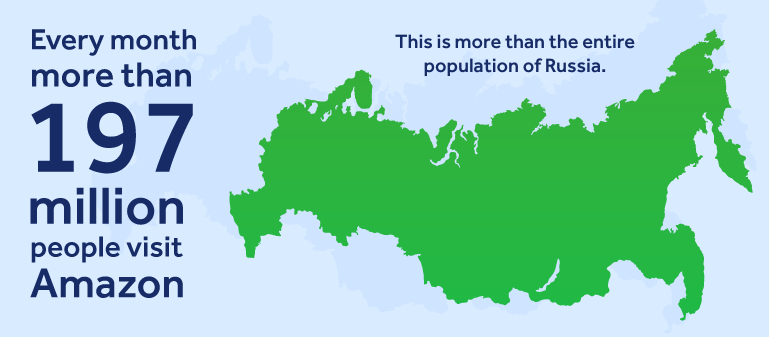
You don’t get this big without breaking some eggs. And Amazon is not without criticism.
Part of Amazon’s growth relied on the premise of a mutually beneficial relationship between them and small businesses. They provide a platform and audience, you supply the products.
But with big names like Nike ending their relationships with the platform, you have to wonder: does this work anymore?
Should you trust this global company to help your business and not crush you on their warpath to take over more of the market?
A marketplace of their own
Amazon didn’t start off with the intent of becoming a marketplace. They were an online bookseller in Seattle, packing and distributing the books themselves at a local post office.
But rather than sit still, Amazon’s success relies on seeing a gap and utilising their strengths. That’s their secret. They had faster delivery. Faster checkouts by patenting the ‘1-click checkout’ in 1999. Why should they limit themselves to books when they can ship and sell everything using their system?

It’s their ethos of being “fast”.
The same ethos which seems responsible for the unjust treatment of their own employees.
To be faster than everyone else, their employees are expected to pick up an item every 8 seconds. Every move is monitored, including their bathroom breaks. And, as a warehouse employee told The New Yorker:
“I’ve seen people who aren’t even thirty years old get injuries they’re going to have for the rest of their lives, but whenever we ask for the speed of work or the repetitive motions to be changed we’re told it’s not going to happen”
The article detailed one injury, where 22-year old Safiyo Mohamed tore an intervertebral disk in her back bending over to pick up a box. The pain from this injury will be with her forever. Mohamed claims Amazon did not care at all, saying “if you can’t work all the time, you are nothing to them”.
Mohamed continued, stating:
“How am I going to have a baby when I can’t pick him up, when I’m worried about being pregnant? I’m so angry. Amazon doesn’t want humans, they want robots. I will have this forever because of them. They don’t care at all.”
That’s a bad sign. How can you trust a company to look after your business if they can’t take care of their own employees?
It’s an ethical decision that should not be overlooked.
Sadly, most business decisions don’t come down to whether something is good or bad. Mostly because there is no clear binary. There are shades of grey in everything. As much as people will boo the company down for the treatment of their employees, others will praise them for providing jobs to over 647,000 people.
On average, they add 337 workers a day.
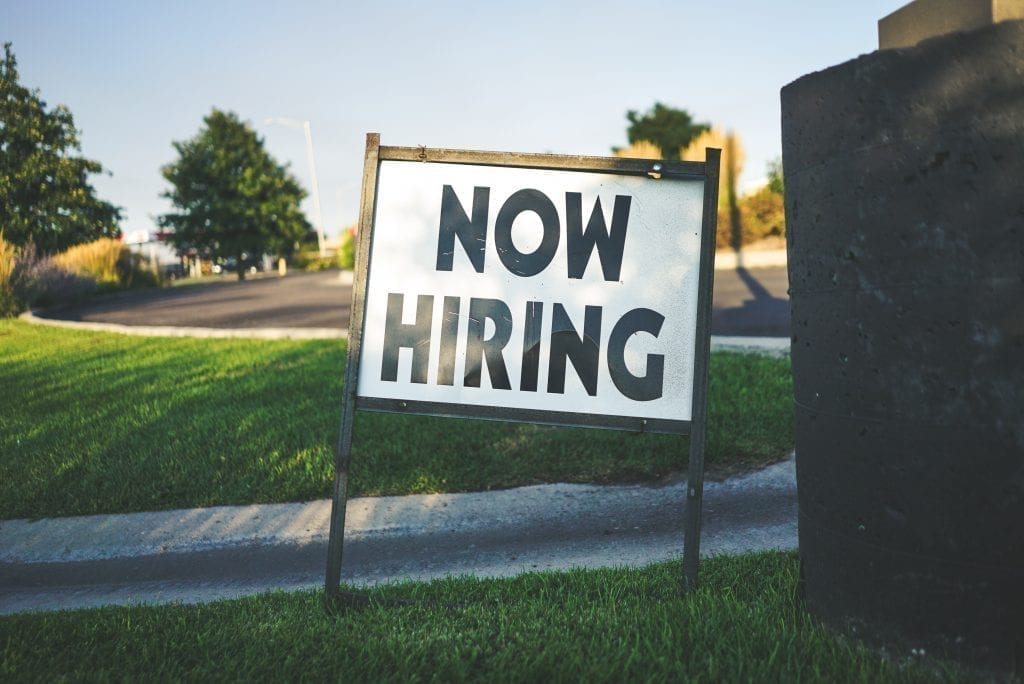
Amazon’s massive growth to accommodate one of the biggest businesses in the world. In April 2019, Amazon had 119,928,851 products listed on their site. There’s no other company in the world that can compete with this.
But these products aren’t all from Amazon. They cannot, under any circumstances, produce and market to that scale. It’s just not feasible. In fact, over half of all Amazon sales come from third-party sellers.
They’ve built a market place and need you to be the venders. But that might not mean that you’ll get much out of this relationship.
Fulfilled by Amazon
Fulfilled by Amazon (FBA) is the company’s scheme for small businesses to sell on Amazon. In exchange for a monthly fee of $40, companies can list their goods on the website.
In addition, Amazon will also take care of storing, packing and shipping.
“FBA (fulfilled by Amazon) was a game-changer for my business. When I switched to FBA entirely, my sales increased by over 300%. I encourage any small business owner to try FBA out. Any business can make it work for them, and once you try it, you’ll love it!”
Tara Reid – The Introvert Coach
Having Amazon behind you isn’t like an ordinary reseller. At the start of the article, we told you that millions of people, equivalent to the entire population of Russia, visit the website every month.
If your company is on that website, you’ve got access to product exposure like never before.
But it’s not just about exposure. It’s about trust.
89% of buyers are more likely to buy products from Amazon [PDF] than any other e-commerce site. That’s because they know Amazon. They trust them, they know exactly how it works and they’ve ordered there before.
If you’re listed on Amazon, you’ve already got the backing and trust of its users.
For a lot of businesses, this equates to more sales and profit. In fact, Andrew Tjernlund of Tjernlund Services got in touch with us to say that FBA has become the largest part of his manufacturing business, earning them annual 8-figure sales from the platform.
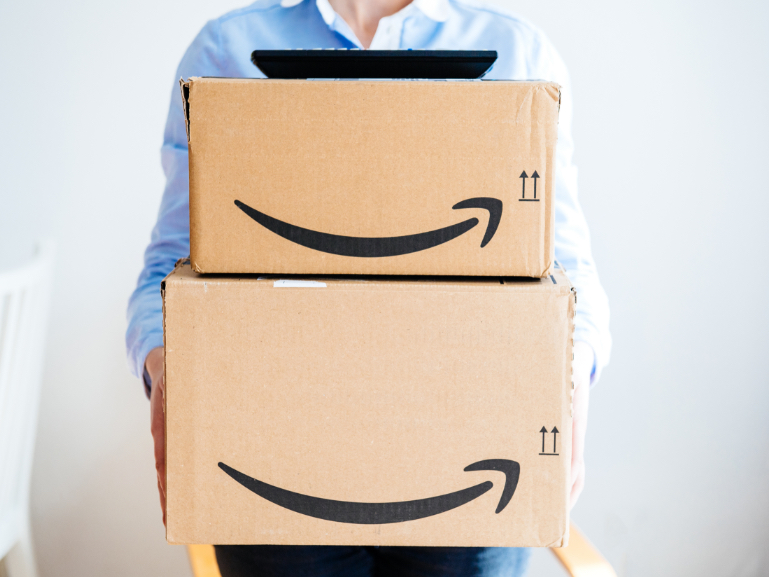
Taking care of the logistics
“Amazon’s fulfilment is not only quick and easy, but it is way cheaper than anything else I have seen. I can purchase shipping through them cheaper than I can by going to the post office, PLUS they warehouse my inventory and handle returns.”
Jason VanDevere – Goal Crazy Planners
FBA doesn’t just give you more exposure. It handles all of the logistics for you.
Amazon, as Kerry Mellin states, Amazon “does nearly all the legwork for us”.
Your product will be stored in their warehouses, clearing up space for you. When an item sells, they’ll package it and deliver it through their own shipping service. Thanks to negotiating deals with the key players in the distribution industry, this is far cheaper and quicker than normal shipping costs.
This means you’ll save time and effort shipping your items while getting a cheaper rate. That’s a no brainer.
What’s the catch of FBA?
If something sounds too good to be true, it probably is. Amazon needs your products to fill their website, but that’s not the only advantage to them.
Your data is.
Don’t worry, they’re not mining for personal data about your company. Instead, they’re using you for market research.
Every business that signs up to FBA is a giant experiment to find out what sells. Market research is a breeze when you are in control of the entire market. They have access to every single figure and piece of data. They know what sells and what doesn’t – so when they want to release their own product, they can pretty much guarantee that it will work. It’s the same way Netflix go about curating content.
If you do well on Amazon, there’s a danger that they will launch their own version that will knock you completely out of the water.
This happened with an aluminium curved laptop stand by Rain Design, which was an unexpected best-seller. Until Amazon released an identical design for half the price, which caused their sales to plummet.
In 2006, Williams-Sonoma sold a unique chair called the Orb. Surprise surprise, Amazon launched their own version also called the Orb, which landed them a lawsuit from Williams-Sonoma.

The controversies have launched an EU investigation this year into whether Amazon is using this data to unfairly promote their own goods in anti-competitive conduct.
Cheaper counterfeits can win
Any marketplace faces competition. You’re never going to be able to sell uncontested.
Despite investing millions on anti-counterfeiting software, Amazon has a big problem with counterfeit products selling on their platform.
A Wall Street Journal investigation found that thousands of products on the website “have been declared unsafe by federal agencies, are deceptively labelled or are banned by federal regulators”. Worryingly, these products include children’s toys that have dangerous levels of lead.
But it’s not just the presence of these sellers that’s the problem. It’s that Amazon’s algorithm is set up to help them win, by valuing low prices highly in their algorithm. This is great for customers looking for a cheap bargain. For sellers, this means you’re trusting a platform who’s algorithm could cause cheaper counterfeits to rank better than you.
Birkenstock is a great example of this. Their customer support system was flooded with people complaining about their shoes, all of which had been purchased from counterfeit sellers on Amazon.
When they asked about the counterfeits, Amazon simply replied that they “couldn’t divulge private information”. What a nice way to avoid responsibility. Unluckily for Birkenstock, this wasn’t the worst part.
Not only were they losing business due to counterfeits, but Amazon had also started buying enormous numbers of stock to resell on their own site. By the time Birkenstock discovered this, Amazon already had over a year’s worth of stock in their own private stores.
This gave them the power to destroy their brand by selling their product however they wished. It was a lose-lose situation for Birkenstock.

Price is a big factor in their algorithms, but it’s not the sole way it’s calculated. Factors like user views, shipping and seller rating also play a role here. But don’t put it past counterfeit companies to submit fake reviews and try other cheap tricks to fool the system.
Some companies are even paying $10,000 a month to illicitly trick their way to the top of the system. Although most small businesses don’t have that kind of money, it’s worth bearing in mind that you’re not contributing to a completely fair marketplace.
The playing field isn’t even. It’s up to you if you want to enter the jungle.
Tackling the competition with PPC ads
There is another way that you can make your product stand out on Amazon. That’s using their PPC ads.
If you’re used to using PPC on other platforms like Google, you’ll be in for a little shock with Amazon. They are different from any other platform you’ve used before and will get some getting used to.
For those that are new to Amazon PPC, you can advertise in the following ways:
- Amazon’s own SERPs. These ads will show as products either at the top of the results or in between entries depending on the device.
- Headlines. These are three or more products that appear in their own banner ads at the top of the page, accompanied by some text for extra advertising real estate.
- Product pages. These appear on the product pages themselves, usually in a “sponsored products related to this item” box.
- Off-site marketing. Like Google Ads have the display network, Amazon also has a way of advertising their products on banners on different websites.
- Email newsletters. Now, this one is a nice bonus that no one else offers. Amazon generates emails for their customers and sometimes throw in a few targeted sponsors inside.
It’s a lot of options, with big potential to increase your sales. In fact, with just one simple search, users can be exposed to dozens of different product ads.
For example, let’s search for hot water bottles.
At the top, the headline adverts were for ThermaCare pain relief, who were properly bidding on the search based on the assumption that people with muscle injuries are likely to sooth it with hot water bottles.

At the top of the results, 4 sponsored SERP ads were positioned at the top of the product list.
These ads copy the exact style of the rest of the results and are impossible to discern bar the small “Sponsored” text underneath the ads. They are done in such a way to appear that they are naturally at the top of the algorithm, allowing sellers a way of battling the counterfeits.
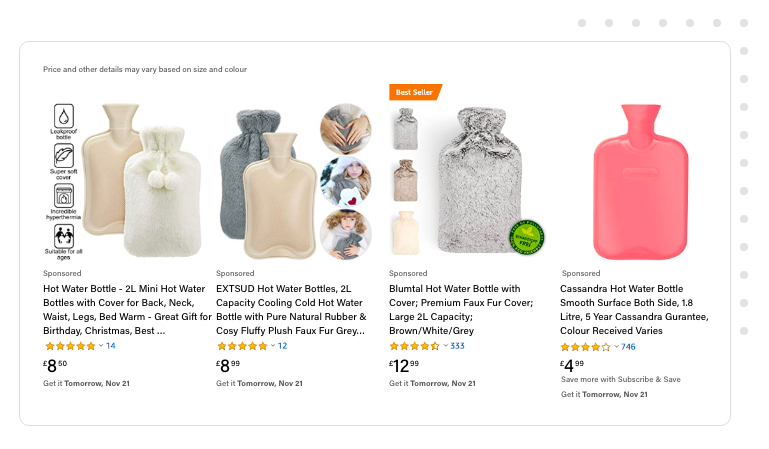
At the bottom of the search results page, there was another row of sponsored products that are designed to look just like the listings above. But with their own row, they are more obvious advertisements than the SERP ads.
In terms of product exposure, you can’t really go wrong with Amazon PPC.
And some small businesses have profited greatly from it, finding better ROI than other platforms. At a talk at the BrightonSEO conference, Prabhat Shah revealed that some of their clients were actually moving 50-60% of their allocated Google Ads budget to Amazon because of the success they’ve had.
Don’t get too comfortable yet.
These are the good points, now let’s have a look at the bad.
Is PPC more hassle than it’s worth?
Let’s not beat around the bush here. Amazon’s PPC system is difficult to use and set up, especially if you’re new to the PPC world.
For some small businesses, this skill cap bars you from getting a return that’s worth it.
“I used Amazon’s PPC service for a few months and didn’t find that it helped much. Our budget was around $200/week. That amounted to a few extra sales but barely enough to justify using the program. I would not recommend it based on my experience.”
Mike Greig – NinjaBudgeter
If you’re willing to put in the effort to learn it, there’s no reason why you can’t profit. Like Jeff Moriarty tells us:
“With Amazon PPC, we wasted a lot of money in the beginning, because we didn’t quite know how to use it. But after researching online, we were able to make it work. And it helps. We see about 40% of our sales coming from the Amazon PPC program.”
Part of the Amazon PPC learning curve is understanding how important competitor bidding is.
PPC doesn’t just give you a chance to make your advert stand out. It also gives people a chance to essentially steal potential customers directly from the competition in a way that’s not possible on other platforms.
Amazon allows you to run ads on specific product pages. As well as more rows of Sponsored products at the bottom of the listing, you can also see an ad underneath the description like the following:
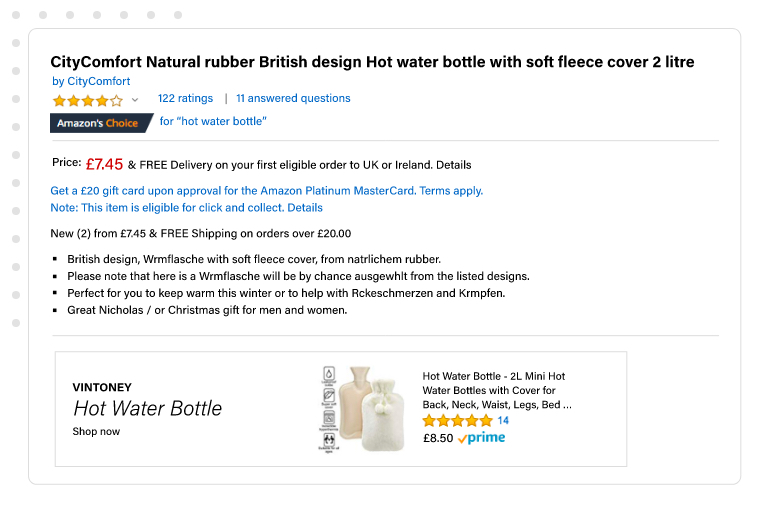
Wow. That’s a bold move. You can attract customers who are one click away from buying from a competitor to your product instead.
Heavy competition isn’t the word for some searches. It’s a cut-throat scene.
Both a help and a hinderance
“They don’t have great worker conditions, to put it mildly, but they’re hardly as bad as the fashion or mining industries. Their logistics infrastructure is the best in the world, and they’ve got one of the best tech solution offerings in the world in AWS, thanks to their internal SOA engineering culture. Are there things they should do better? Sure. Veting[sic] all marketplace sellers, human customer support and lots of it, and greater focus on reviews and listing manipulation would be lovely. But I’d say they’re a net benefit to business specifically, and the world more generally.”
Pete Watson-Wailes – Tough & Competent
As this article has proven, there’s no easy “good or bad” answer when it comes to Amazon. I can’t just circle an option and move on.
If you’re wondering if Amazon is good for small businesses, the really awful answer is that it depends. Sorry. It feels like a cop-out, but it’s true.
For some small businesses, Amazon is a fantastic way to gain exposure, increase your sales and get a much-needed boost to your profits. For others, it’s just not worth it.
But there’s not a clear conscious on which small businesses can benefit from Amazon. For John Moss, it depends on the type of product you’re selling. Anything that was bespoke or made to order would not survive on the website.
But using Amazon for their standard samples or test goods, they found that their “available product lines sell much faster when offered via FBA than by means of direct shipping”.
For Christopher Nelson, success is based just on size, as he states “unless you have a massive budget, I don’t see how Amazon is an effective small business selling site”.
Amazon has the power to either save or kill your business. You can only really know for sure if you try it.
If you need a hand with selling on Amazon, check out Jungle Scout – your all in one platform for selling on Amazon. They can help you grow your business, start selling and explore agency and brand solutions.
A necessary evil
Out of curiosity, I posted a simple poll on Twitter to get a general consensus of how people feel towards Amazon. The most common answer? That they are a necessary evil. And I think that sums a lot of feelings up pretty nicely.
Particularly paired with this quote from Calloway Cook of Illuminate Labs, which nicely echoed the feelings of lots of similar businesses.
“Amazon is a necessary channel for eCommerce businesses that sell exclusively online, but they can be very frustrating to work with. Once you sign up for a Professional Seller account, which costs $40/month, you get assigned an Amazon rep. In my experience (I’ve dealt with two), the Amazon reps take an extremely long time to respond to your questions. I’ve sent my Amazon reps troubleshooting questions that took them over a week to respond to.
“Selling on Amazon is still absolutely worth it for our business, since the vast majority of our market buys on Amazon. I just wish they took small businesses more seriously.”
And that’s the key problem, isn’t it? Amazon needs small businesses, but they’re at a size of unprecedented growth that they don’t need to take small businesses seriously. They call the shots.
You either play along or make do without them.

An unmoderated platform that will spiral out of control
Amazon is the biggest online marketplace in the world. But their size is something that will cause their downfall.
They let almost anybody in. If you’ve got a product, you can sell and advertise on Amazon. It’s free for all, with only one clear winner: Amazon.
There’s not enough of a moderating process for sellers, which is why the platform is ripe with counterfeits. There’s not enough help and support for sellers either. If you’ve got a problem, Amazon just doesn’t care enough. It’s not big enough to impact them in the grand scheme of things.
They just want to continue their growth.
It’s not just Amazon, the online retailer. It’s Amazon, the suppliers of Kindle and home of the Ebook. It’s Amazon, land of the voice assistants where Alexa is queen, ready to answer your questions. It’s Amazon, with its streaming service and growing film studio.
But that might be their downfall.
There’s only so much growth before you can collapse. You can’t monopolise and dominate every market out there. There will be a point of no return. And if small businesses decide they no longer need Amazon, this could trigger their end.
Only time will tell.



